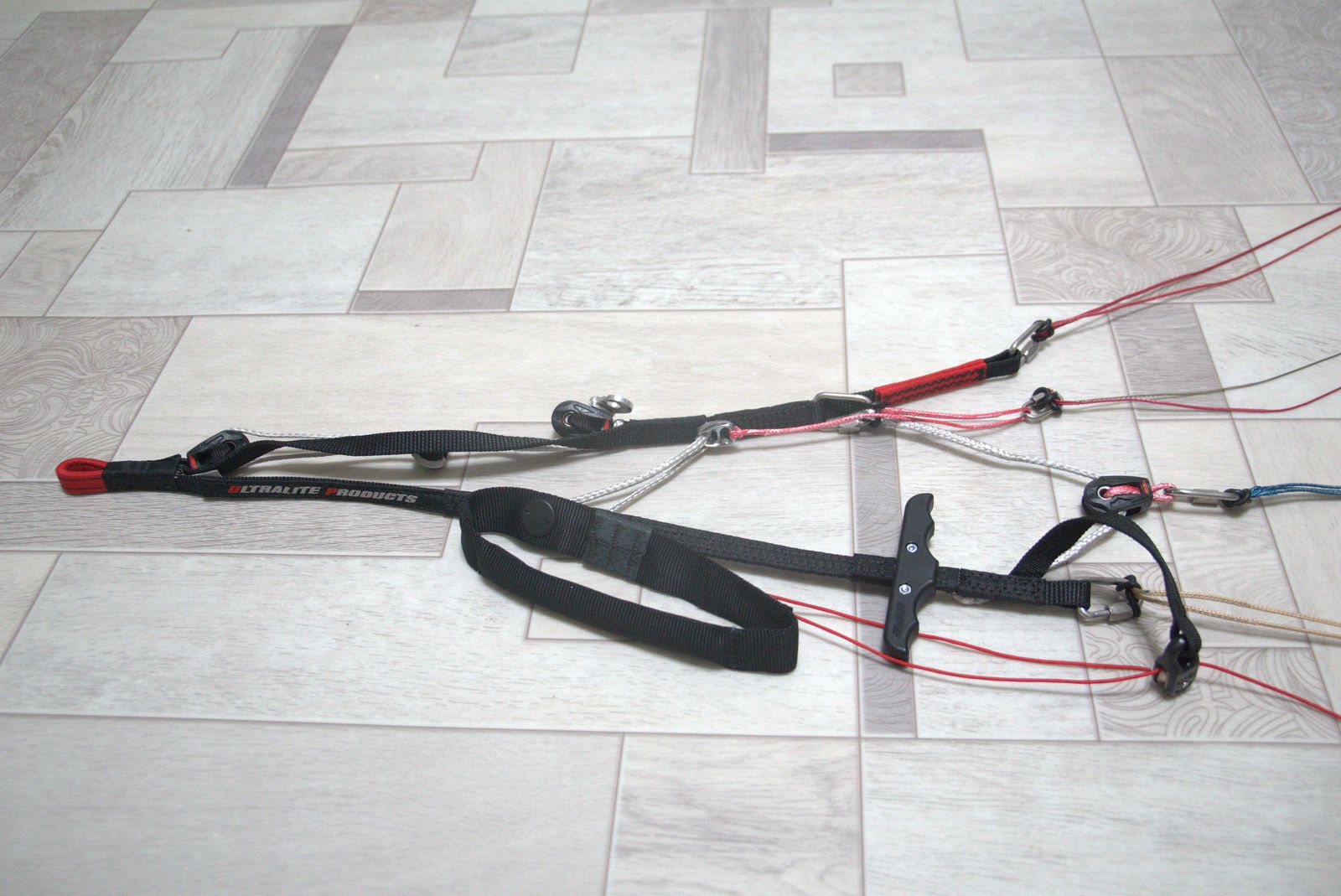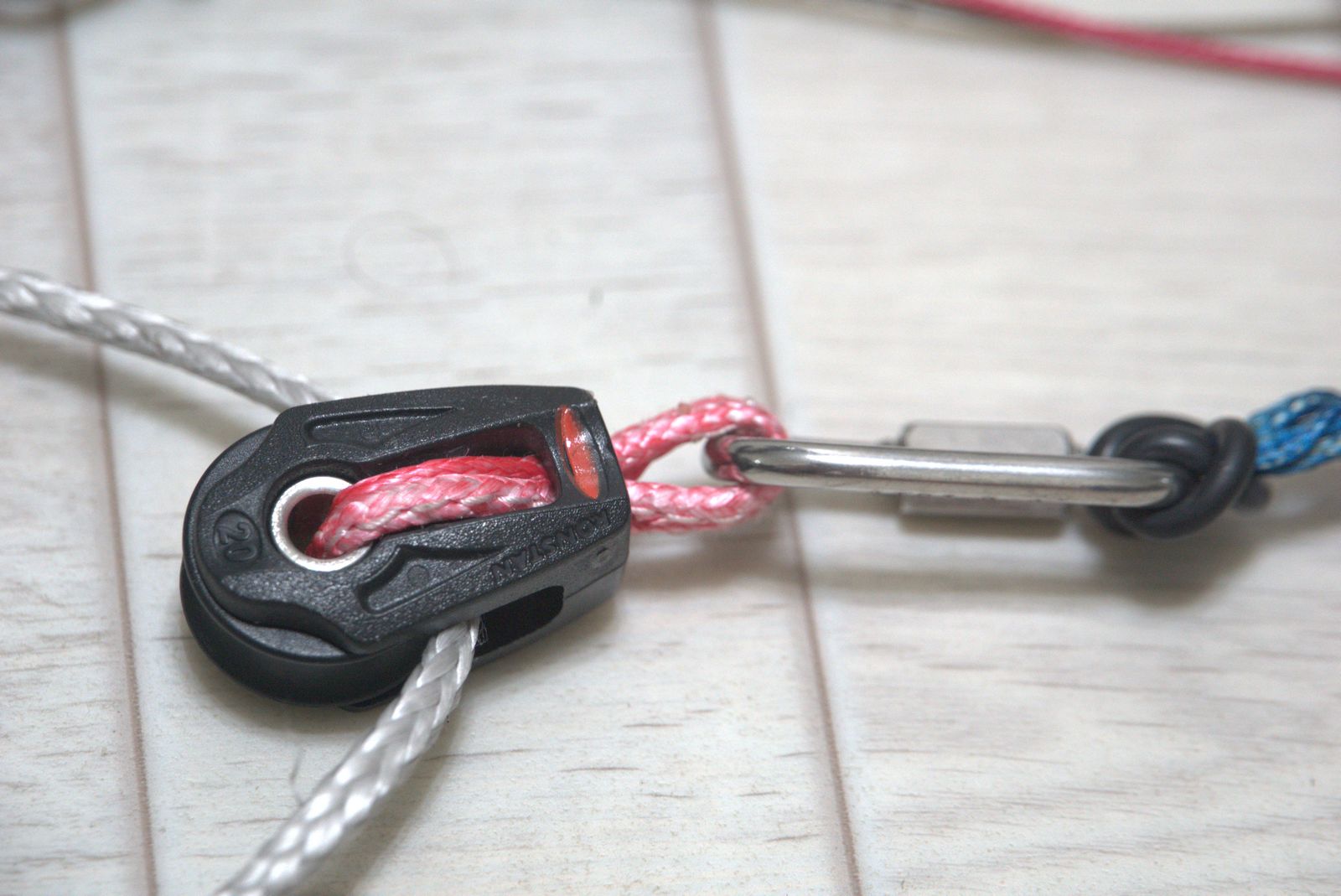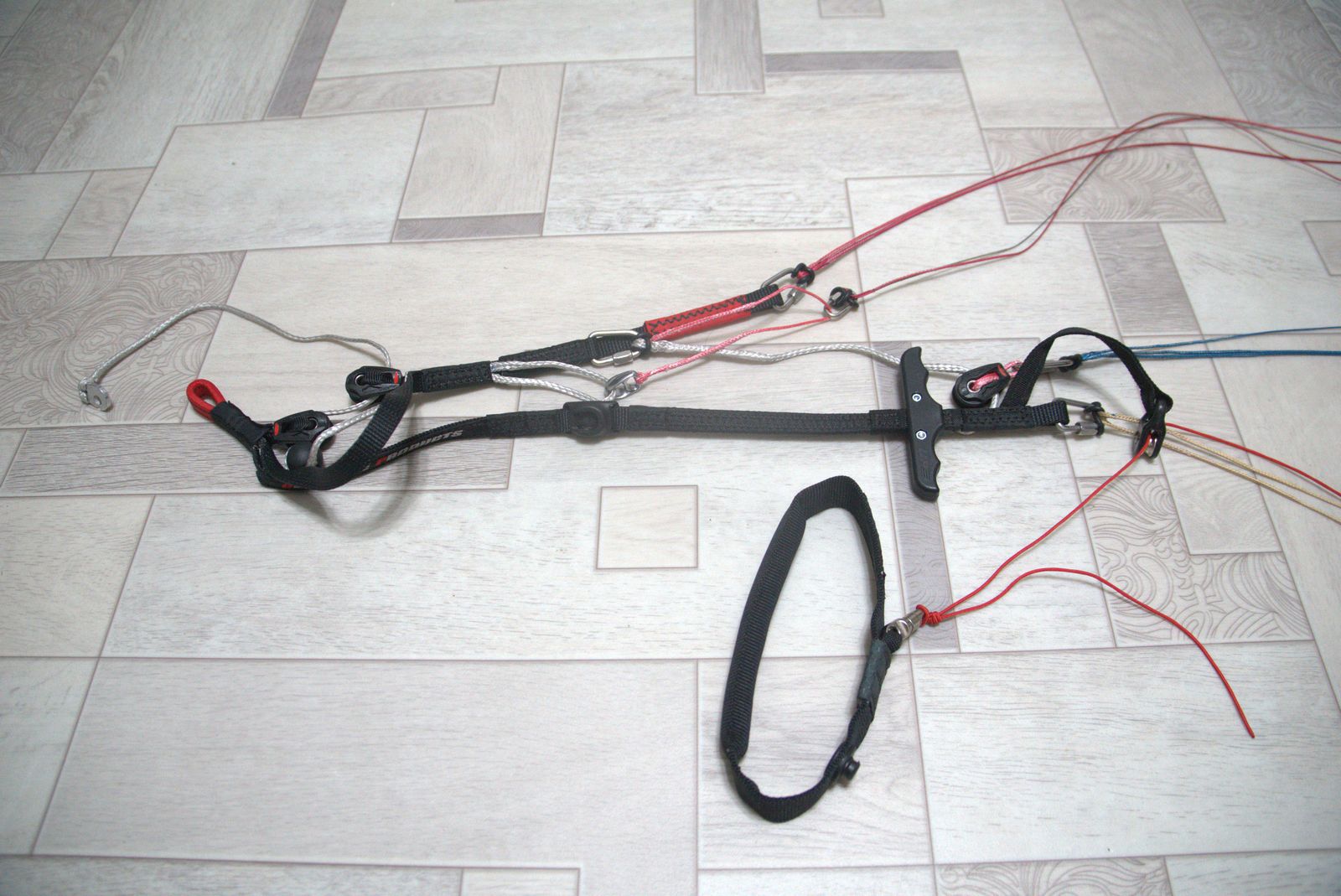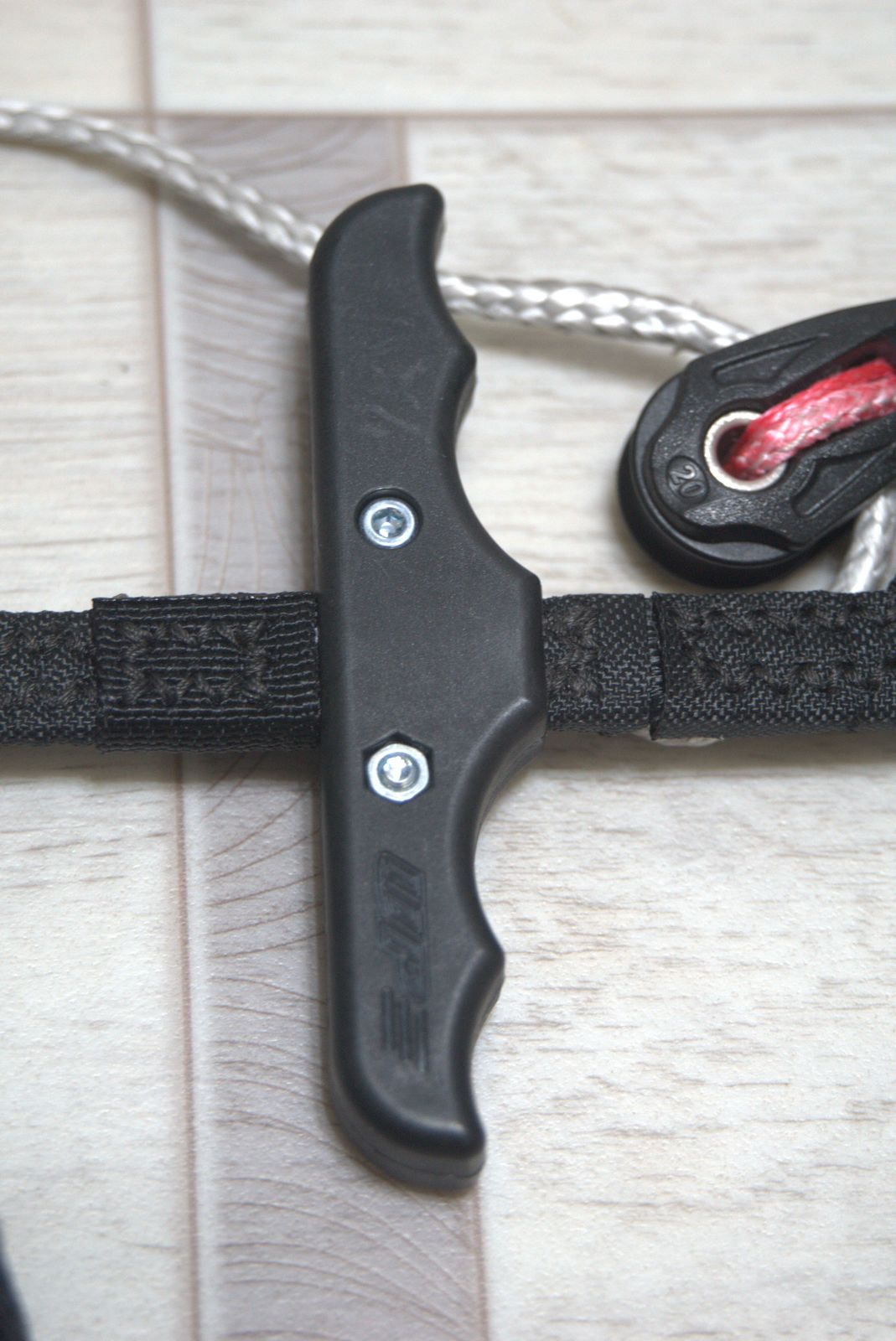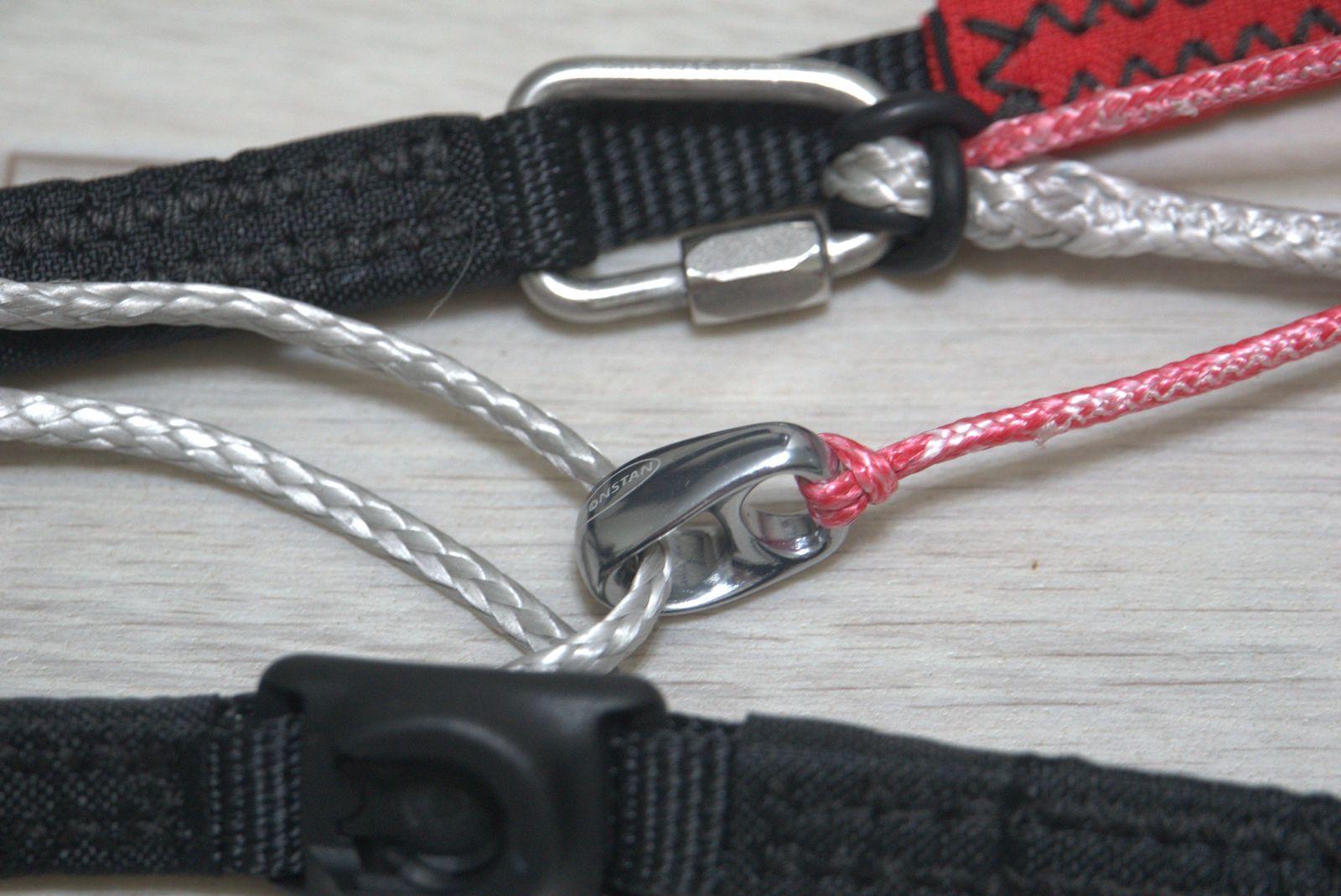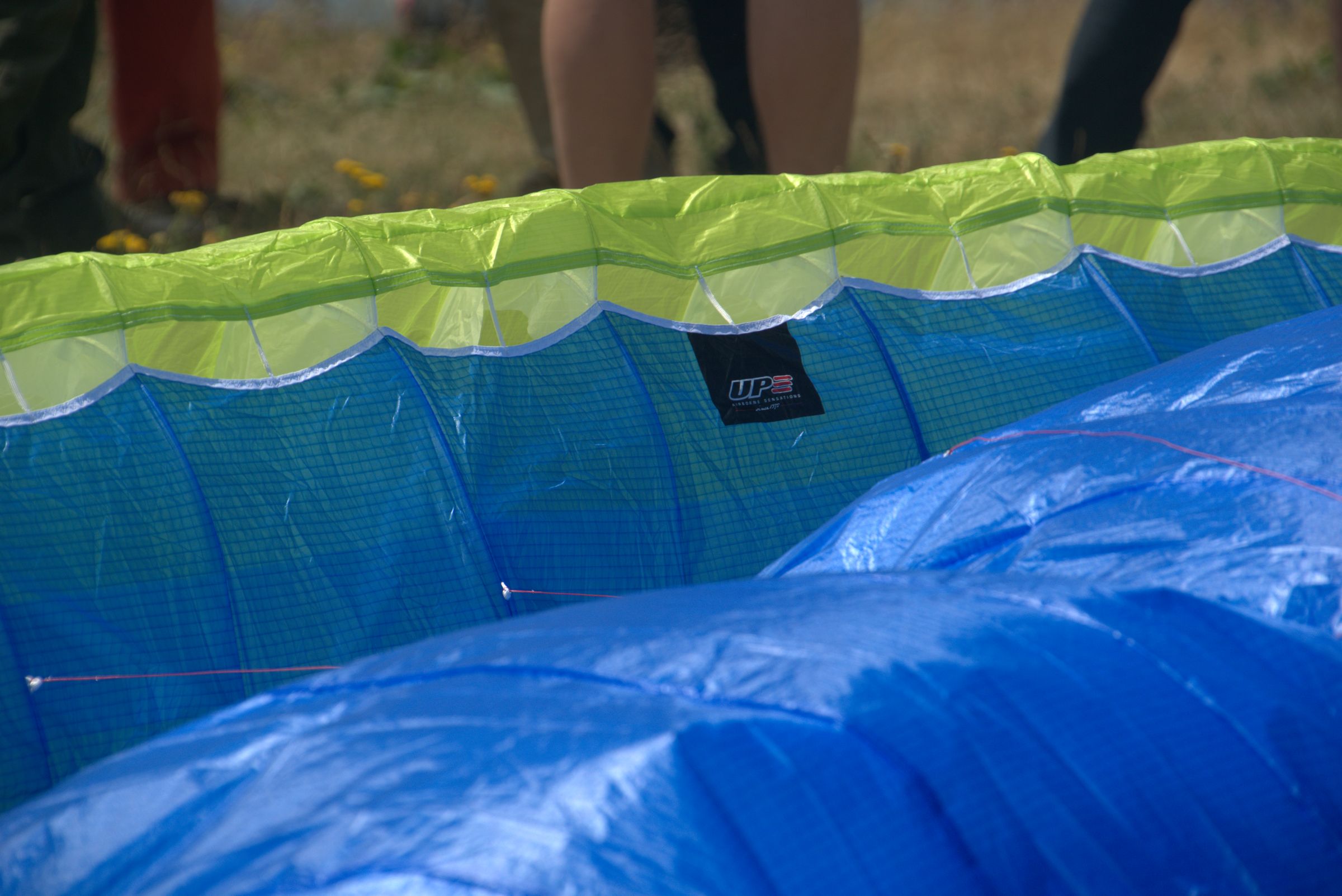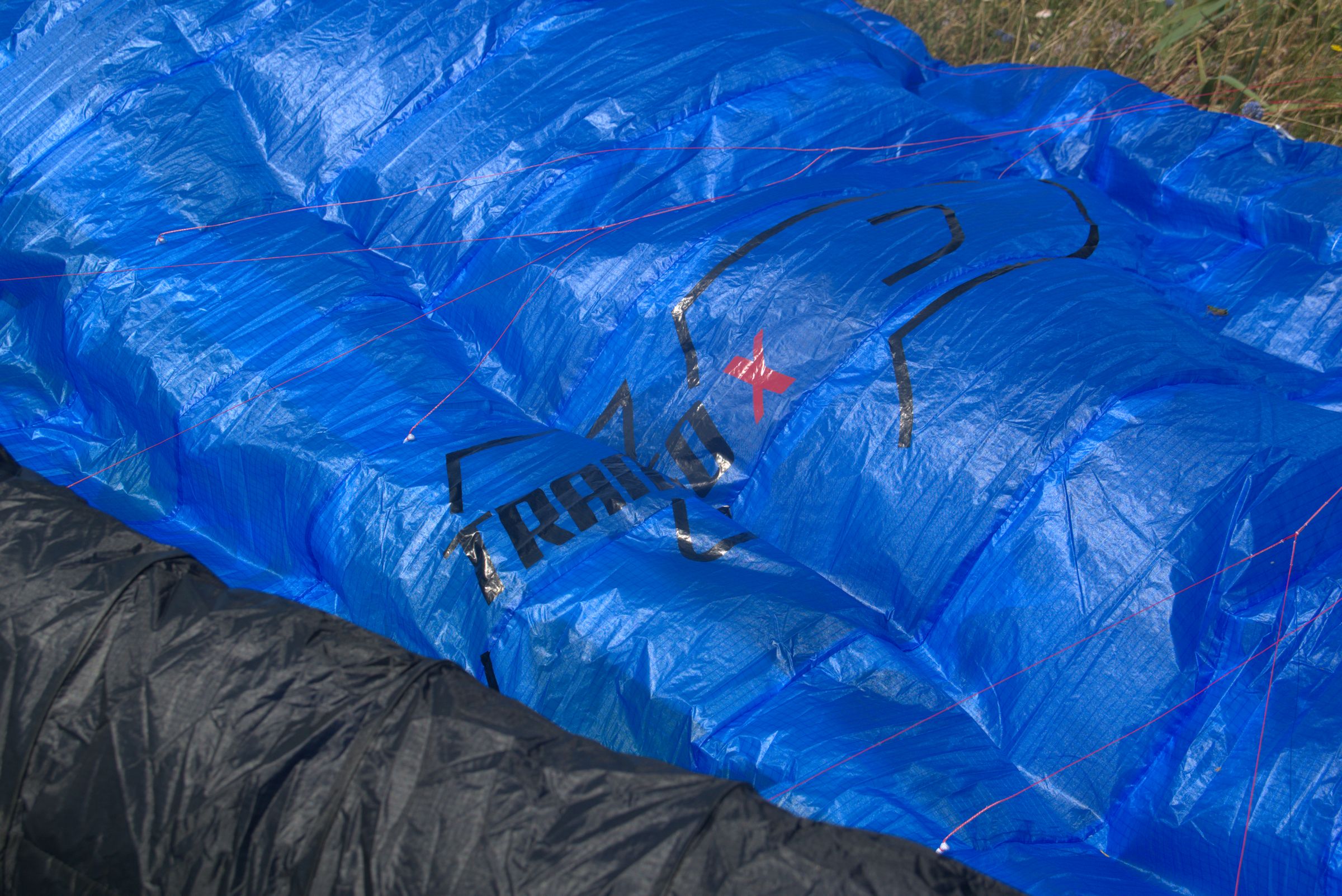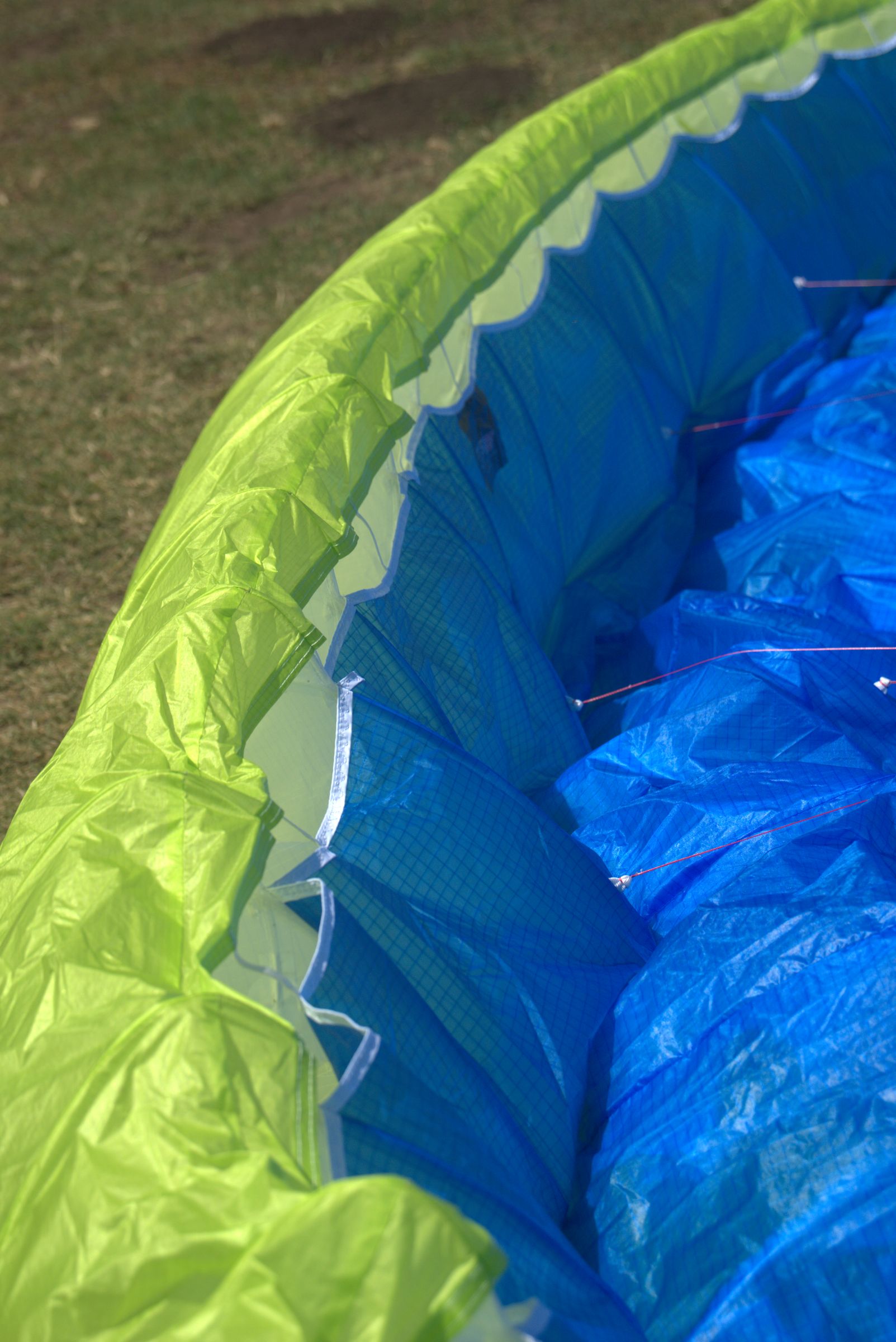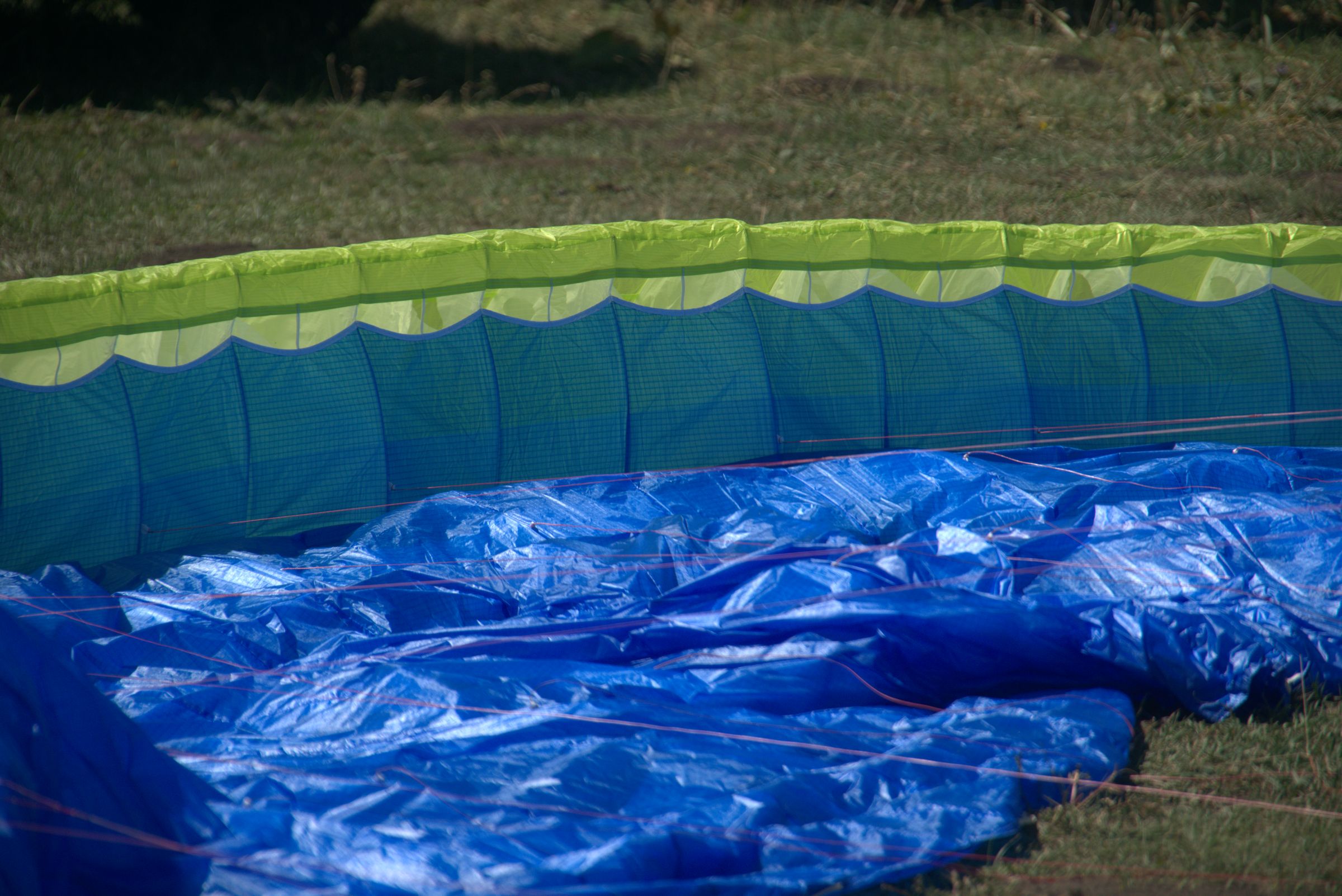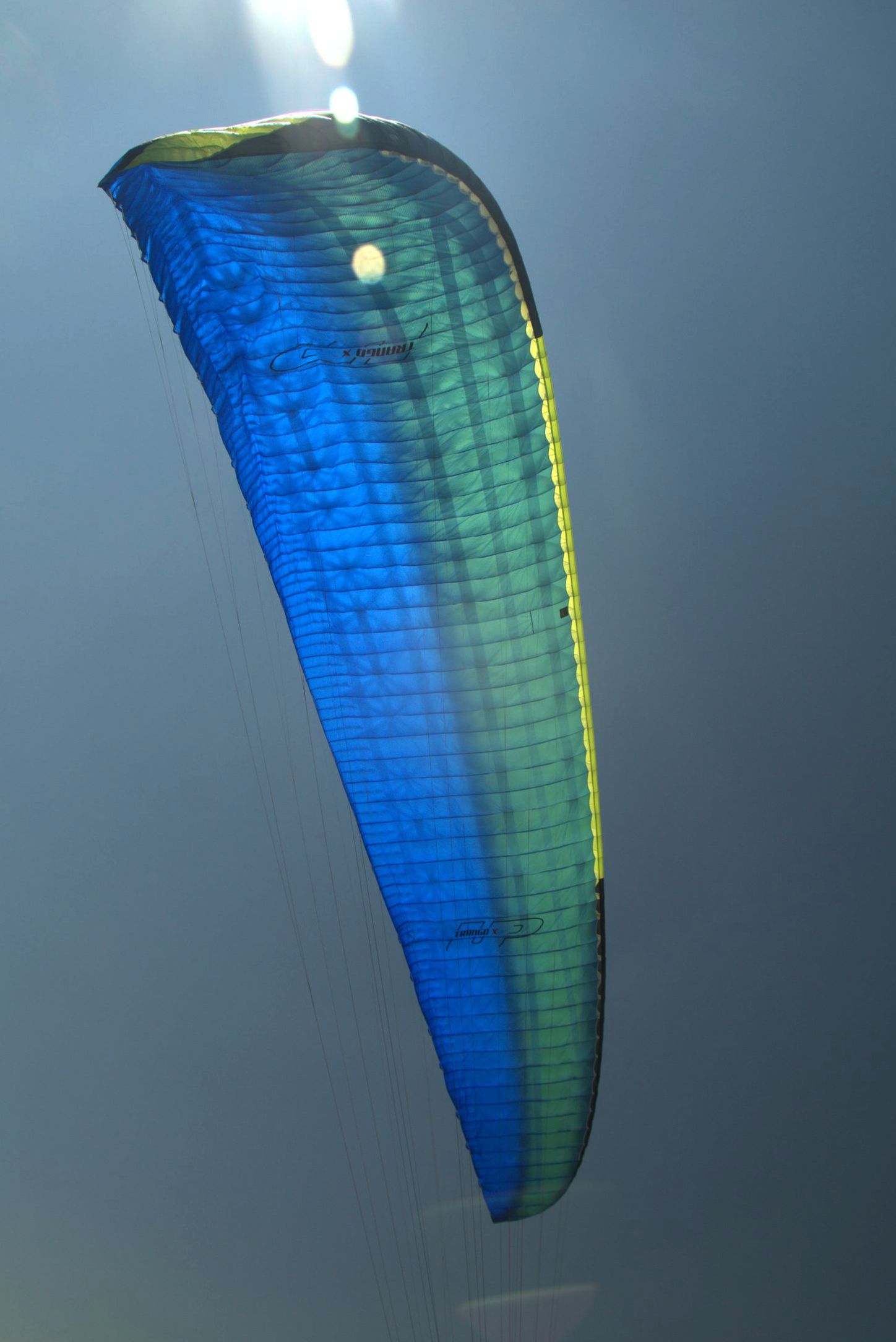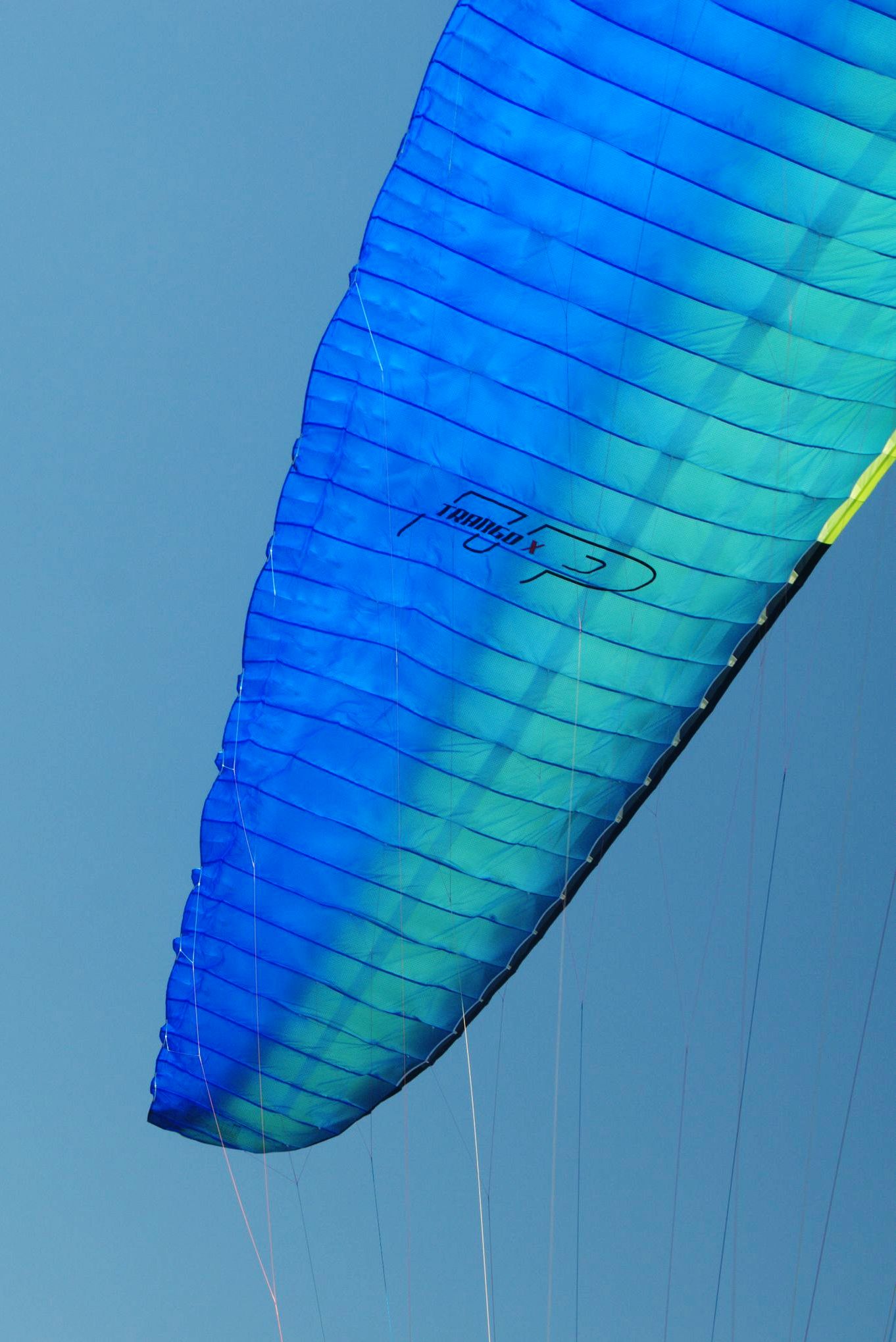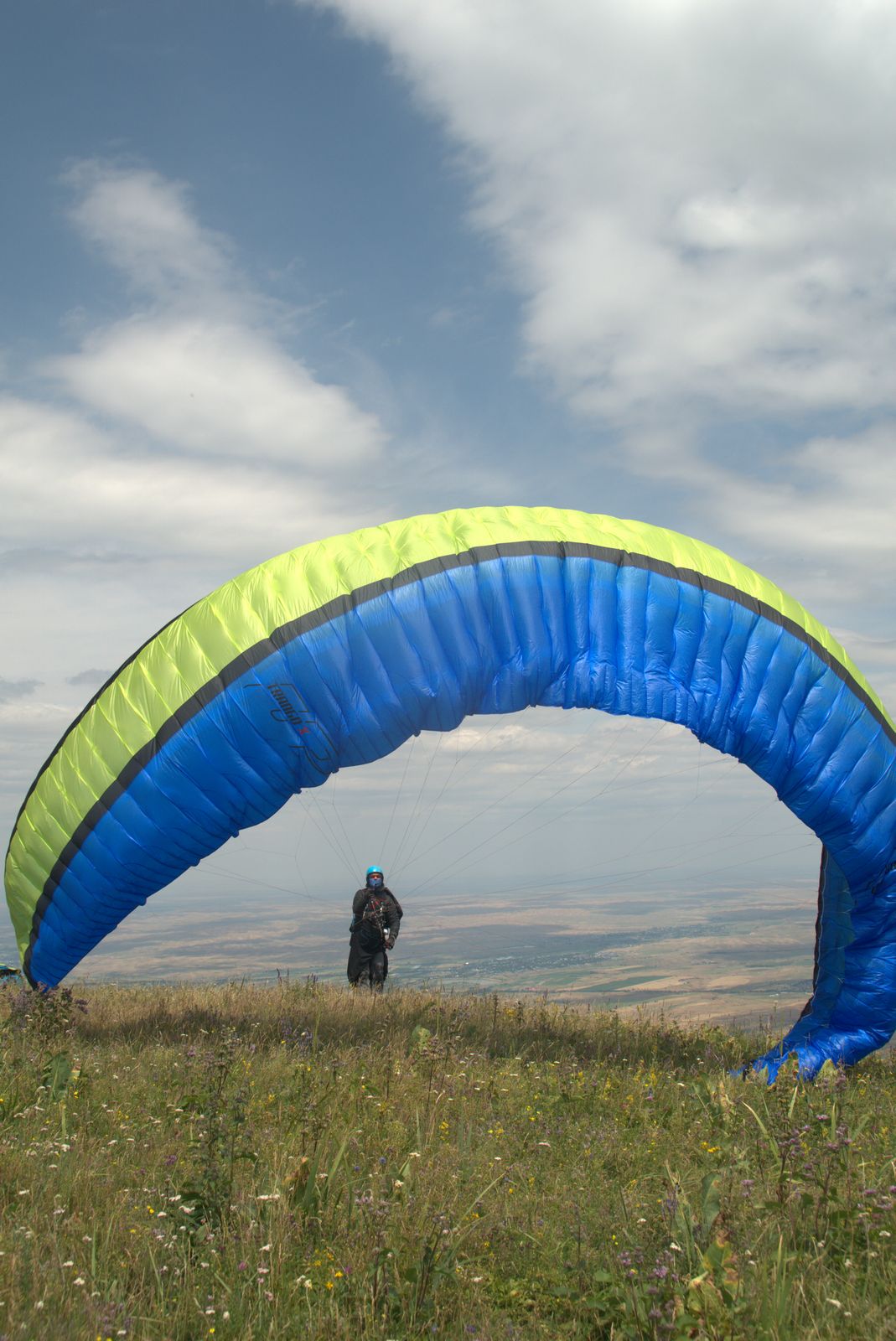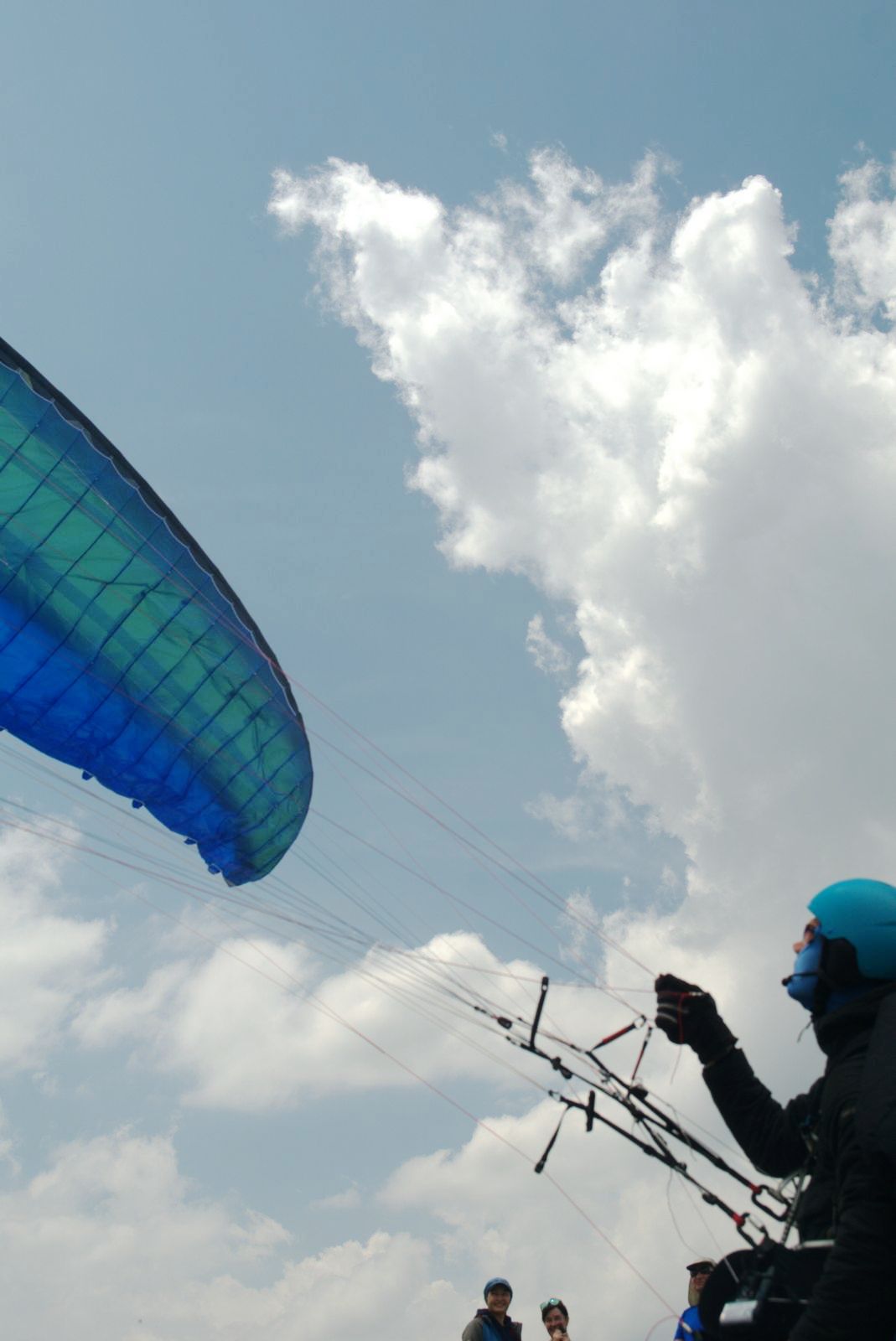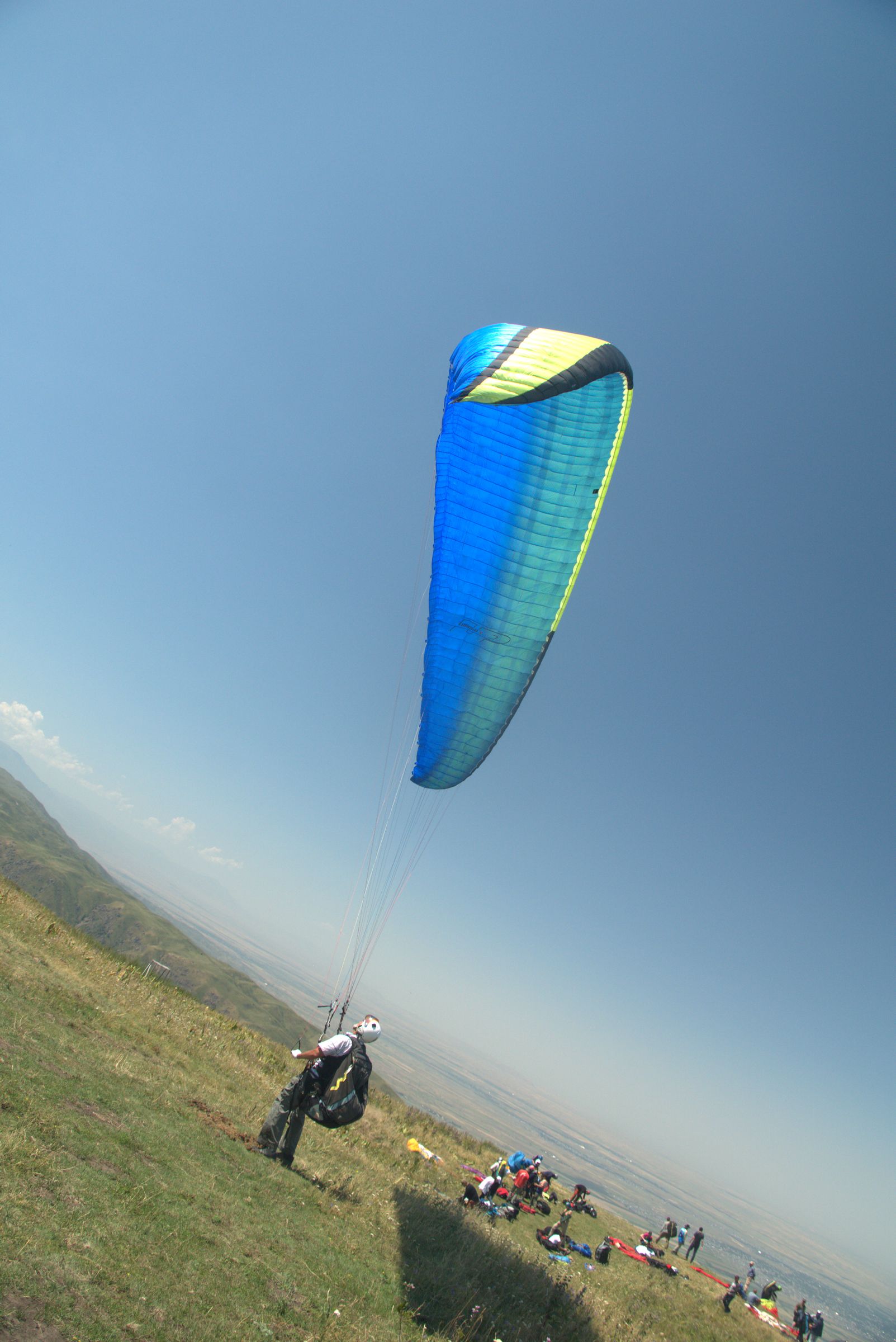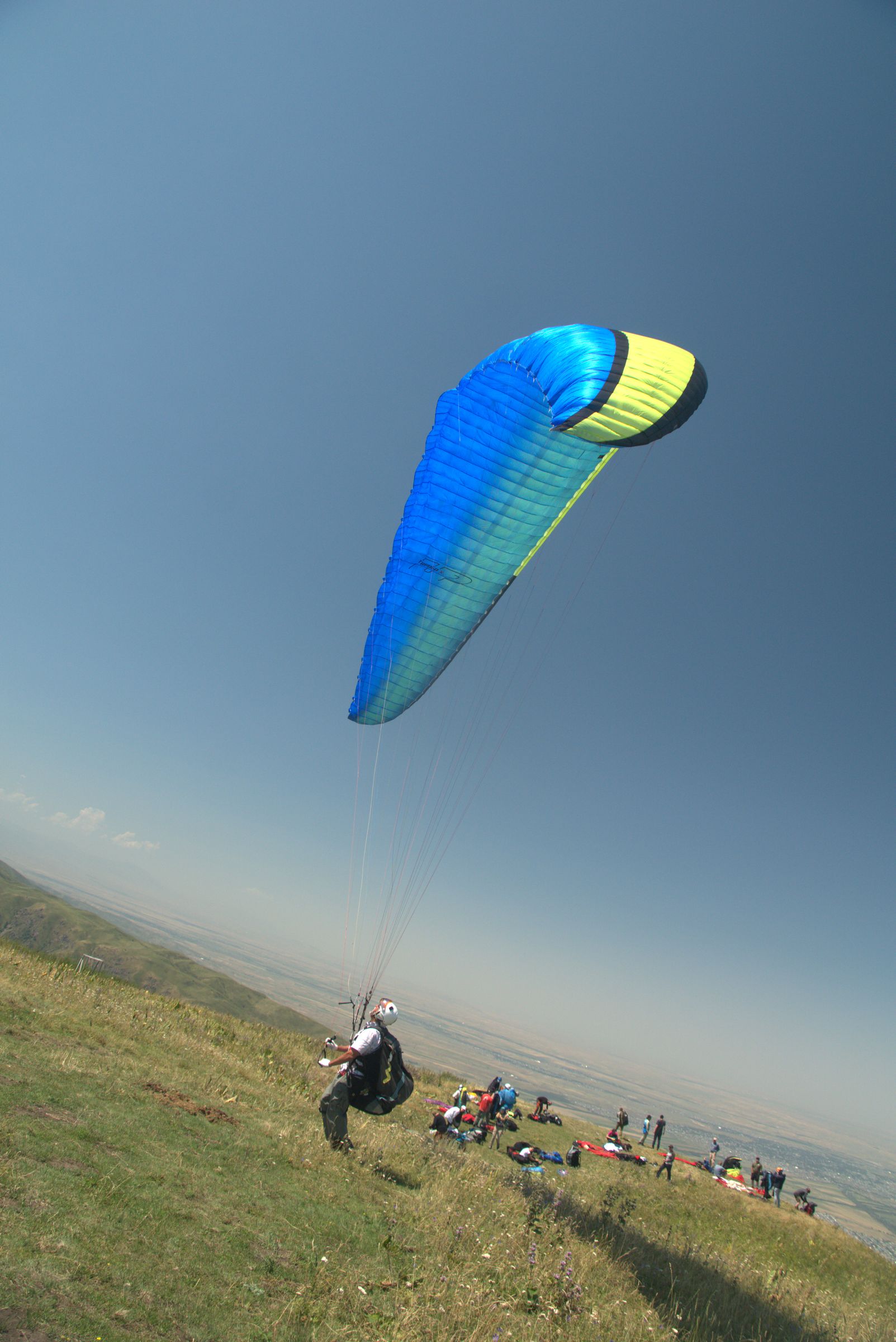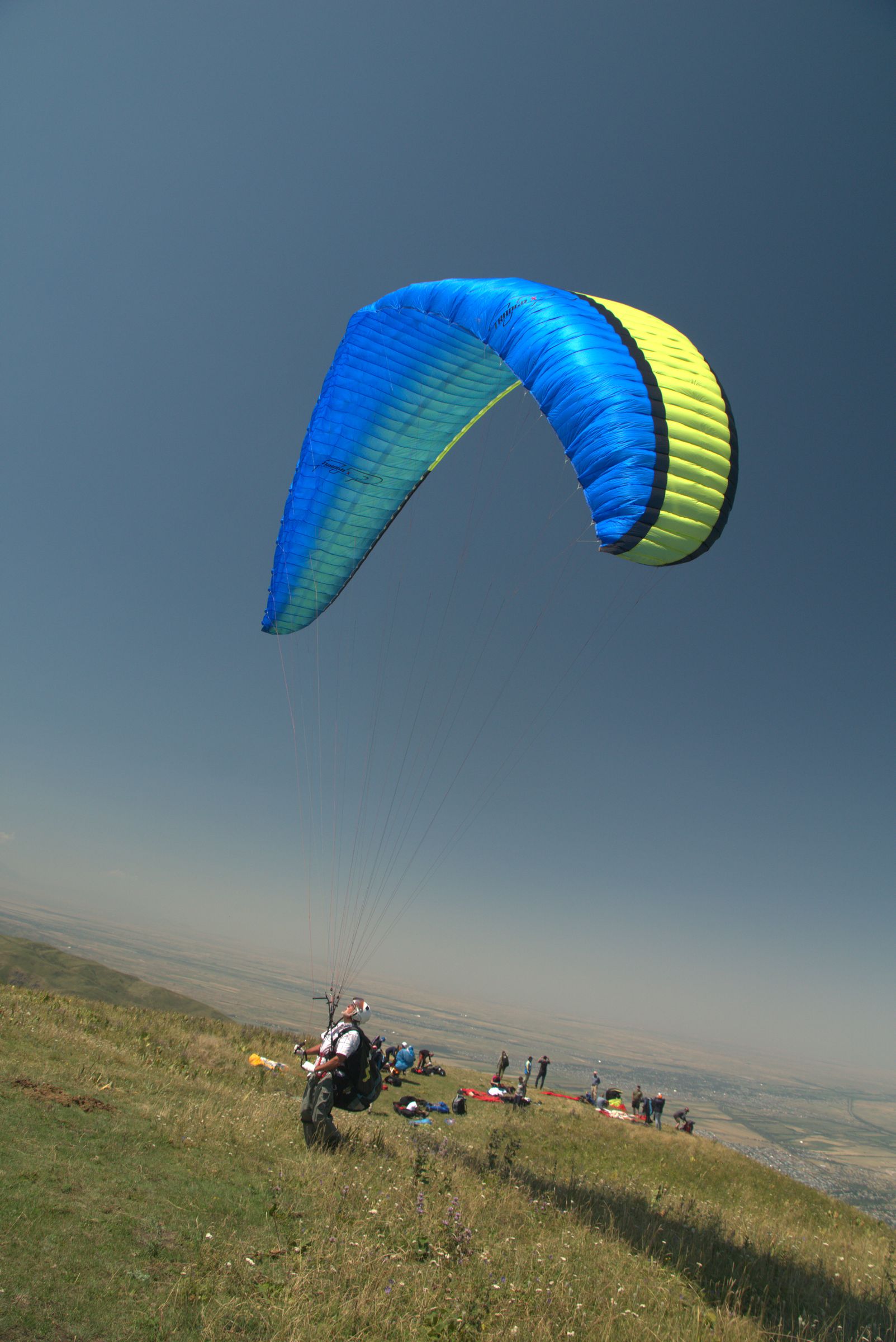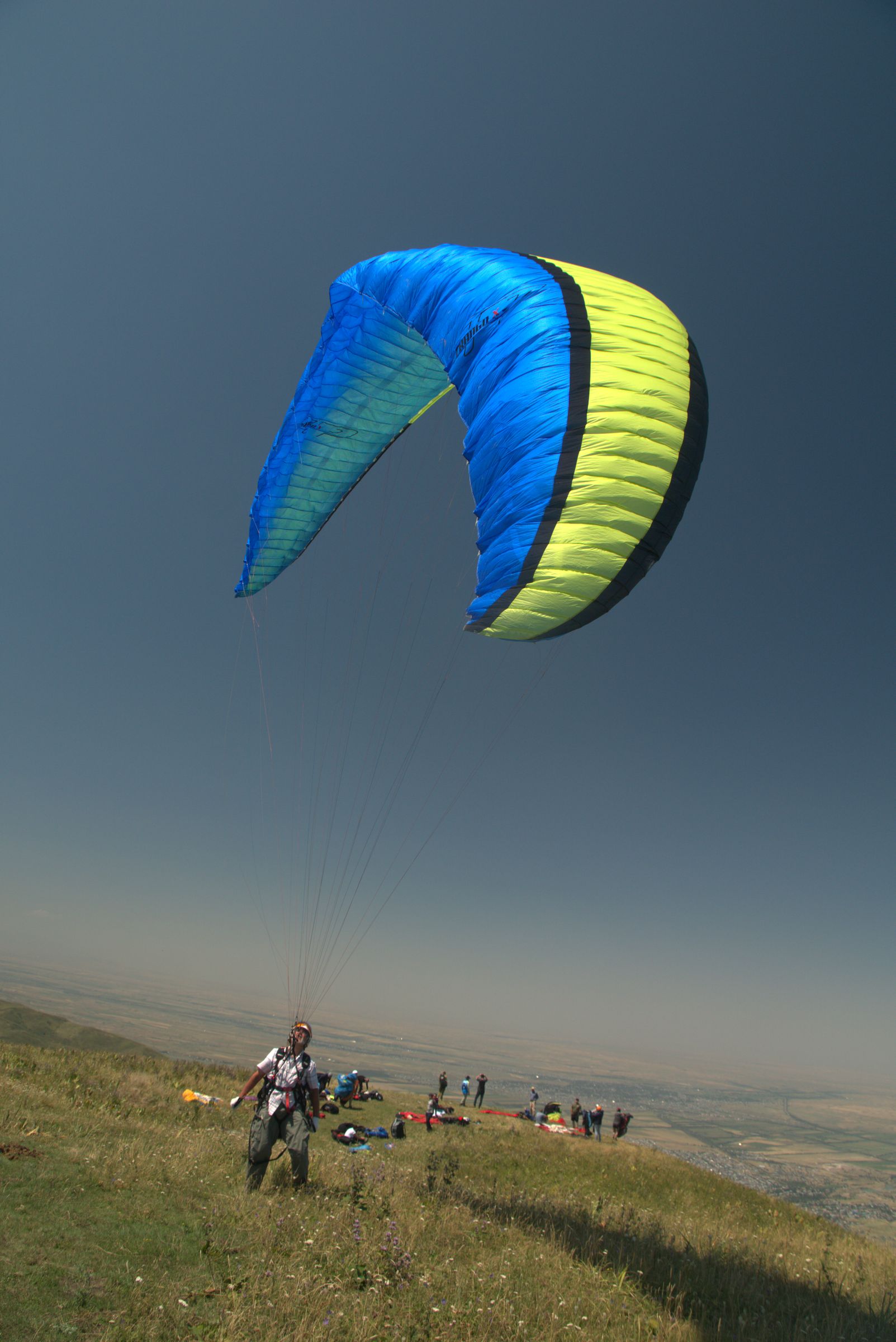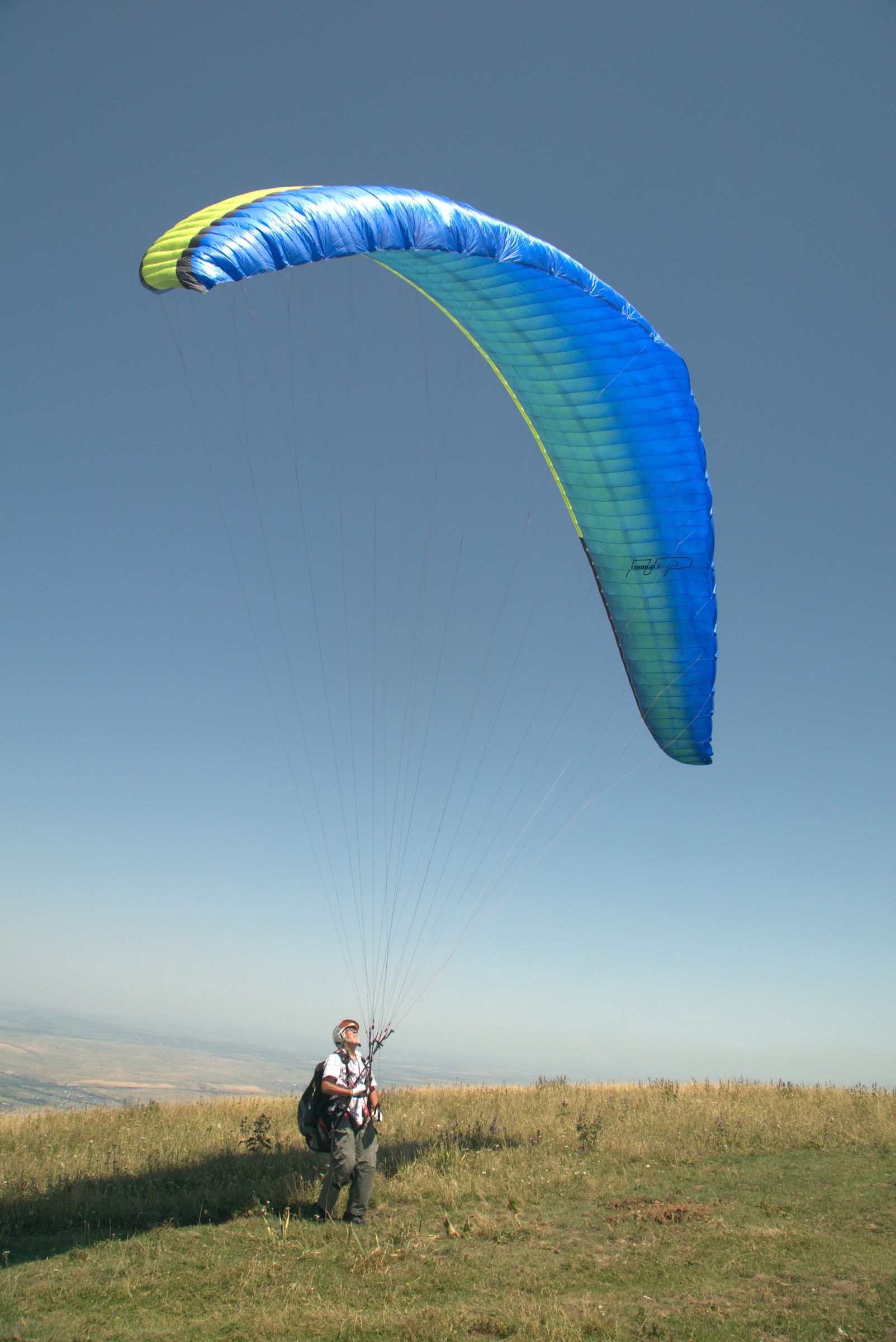In the early 2020s, the once famous UP company seemed to disappear from the radar. New wings with the UP label kept coming out, but the market hardly noticed them. In order to bring attention back to them, they needed to do something really different, and I think UP has succeeded. You can't call the Trango X an ordinary wing!
Design
Risers
The instantly recognizable UP style. A bit more modest than other manufacturers, but not without a twist. The outer line of the A-row rolls over a small steel connector. But the B-row, floating in the best modern traditions, has a large bearing block. Brake leashes are thick, stiff, reasonable length, with blocks instead of rings. Handles are large, soft, comfortable, magnetically attached. The top part of the handle is quite stiff, you can comfortably put your fingers on it. The branded handles on the C risers are hard plastic, ajustable. To move the handles up and down on the C rows, you have to remove two screws per handle. The lines are fixed on the connectors with good old silicone rubber bands - a normal solution, but it looks a bit old-school. In the A'-line wiring there is an interesting buckle of yachting origin - probably it is lighter, but the friction in the system is not reduced.
Lines
There's slightly less lines than average - A2A'1B3C2. The lower tiers are expectedly made of aramid, cheerful, multicolored due to anti-UV impregnation. The thinnest slings of the lower tier have no impregnation. The sling height is relatively small. Despite the three rows, there are not too many slings, so they are minimally tangled at the start.
Canopy
Here's where things get interesting. Previous Trango's, starting with the XC2, had an AR of 7, but the Trango X has a noticeably smaller AR of about 6.5. The number of sections isn't exactly prohibitive, either - 65. But there is the trademark 3D cut, smoothing the nose and rear chord, and plenty of plastic, which Trango is stuffed with from the front to the rear edge. Aw, UP, try nitinol already! ;) The plastic rods are rigid, sectioned. The wing should be placed strictly in the concertina, and it, in turn, should be wrapped around the harnsess - otherwise the rods may be in trouble.
Due to the relatively small number of sections, the internal structure is not too complicated. The maximum unsupported span is only 3 sections, not much by the standards of 2024. But unexpectedly a lot of ties along the span - on the centerplane their number reaches 4, apparently, for a more even distribution of loads on the wing. Air intakes are narrow, interesting rounded shape, tied in the center with a short stitch, as it was in some Ozons. The trailing edge has no rings or eyelets, just short ties - simple and rational.
The shape of the wing is interesting. It doesn't look like the old Trangos. It concerns both arc and planform and, perhaps, even profiles. There is no continuity, we are looking at a product that was obviously created, if not from scratch, then close to it.
It is interesting that Trango X is made entirely of Skytex, and quite light articles, which had a positive effect on the weight of the wing. Even the largest size does not reach 5 kg. Not ultra lightweight like the Niviuk's Klimbers, but nice.
And finally, the looks. Graphic design and all that. For many years, UP wings were famous for their ultra-minimalistic, but very noticeable coloring. To a large extent, it still is to this day. The front and rear halves of the chord are painted in contrasting colors - bright, conspicuous, not to be confused with anyone. But there are additional small stripes on the "ears". In my opinion, they are superfluous, but recognizability is not lost.
Takeoff and ground handling

Ground handling
Come on, you're dealing with a three-liner! And a three-liner with classic behavior. The wing comes up easily, stopping it over the head is not a problem at all. This easy behavior is mostly due to the AR which is quite below 7. The wing rises as a monolith, not trying to wriggle. It feels good!
Takeoff
Once again, it's a classic three-liner behavior. The wing takes the load smoothly but quickly, the run-up is small even with a fairly high wing load.
Flight
Turn ability
Three-liner classics. It's great! Actually, it's very balanced. Plenty, but not too much. The brakes are stiff from the first centimeters of the stroke, and from the same centimeters the wing starts to react quickly and accurately to brake input. Definitely suitable for pilots who like to fly with their hands up. For everyone else I can recommend to lengthen the brake lines a bit, because they have a factory reserve of length, and it is even quite big. Roll behavior is in the best traditions of Trango clan - fast, but without sharpness again. In keeps the lift quite well, confidently, speed and roll remain almost constant. You do not need to to "fight" with the wing, to "shove" it into the lift - everything is good as it is! Reactions to the weight shift are also fast and clear, and also without excessive sharpness. And at the same time, everything is somehow simpler, softer than it was in the previous Trangos with greater AR. That's great!
Glide
Probably, the main question for a glider, which dares to be a three-liner in the era of two-liner triumph. In plus, low AR and few sections... My expectations were not very optimistic, and my first subjective impressions were not very optimistic either. But the first parallel glide with Niviuk Klimber 2P of adequate size changed everything. In my opinion, Klimber 2P was quite a good choice for comparison. Far from the most high-performing in its class, but still EN D with ~7 AR! And yet at 50-60% of the speed system travel, the Trango X glide was just as good! The transition was quite long, relaxed, the comparison was quite fair. Impressive!
Accelerated flight
Raw figures: approximately +10 km/h, approximately +18 km/h. This is how much speed the Trango X gains while flying at 50% and 100% gas pedal, respectively. Not the record in its class, but quite good by EN C class standards. Some two-liners gain less speed while accelerated! The factory overdrive settings are good, the gas pedal is not too long and not too heavy.
A couple of words about rear risers control in accelerated flight. This is traditionally a tricky issue for three-liners - and especially tricky for some previous Trango's, where the rear risers were very heavily loaded. The Trango X doesn't have that problem, the rears are heavily loaded again, but within the limits of what's appropriate for a three-liner machine. Efficiency - well, it's OK. It is clear that the complex kinematics of risers and "extra" blocks somewhat blur the sensation of contact with the wing. But it is quite possible to use it, big convenient handles on the rears are not "for a tick".
Soaring and sink rate
Not disappointed at all! I managed to thermal under overcast skies in very weak lifts. I didn't notice any pronounced floatability and other miracles characteristic for two-liners, but the sink rate was quite reasonable even in tight spirals. In plus, the glider sticks to every lift encountered, the spiral is stable and smooth. It should be noted, however, that my flight weight (~100 kg) corresponded to the middle of the weight range. At higher wing load the behavior may be different.
Comfort and feedback
Comfort
Feedback
There are specifics, but not many. I'll start with comfort. There is some interesting "rubberiness" in Trango's behavior. When getting into noticeable turbulence, the wing reacts to it with short movements, which start rather sharply, but stop very quickly and softly, as if "bogging down" in something. In general, I cannot call this behavior aggressive or uncomfortable. Due to a small AR Trango is neither "snaky" nor "wobbly" , it moves above the pilot's head in a block. Collapse resistance is high, a couple of times the wing slightly crumpled when I was falling off the lift, but it did not come to a full-fledged collapse.
The Trango X is perhaps a little less informative than its predecessors. But this is not a problem. It's like Trango's maneuverability - a lot, but not excessive, just right. It is also nice that the information transmitted by the wing is simple and clear. No "special two-liner magic", no need to learn and get used to it. Okay okay, there is still a bit of magic. At the far periphery of the lift Trango X begins to drift towards the thermal, making it easier to find. The core, once reached, on the contrary, tends to throw Trango X out - but it happens not too sharply, and the high efficiency of control allows you to confidently keep the wing nerar the core. The best feedback are the changes in airspeed. You may also feel it by the variations of brake loading (again, this Trango's brakes are quite heavy). The risere will give You some feedback, but much less than airspeed and brakes.
Dynamics and energy retention
Dynamics
Energy retention
Just what you expect from a three-liner wing with non-monstrous AR. Wingovers are peace of cake, and there's no stunning effect which some of Niviuk and Skywalk gliders may create. You can get to 120 degrees roll in a couple of movements. Trango X reaches 90 degrees of roll comes quickly and easily, but you need to make more inputs to increase the roll. The pleasant understandability - or is it understandable pleasantness? - behavior is always present. The glider stores a lot of energy, but - yes, you guessed it! - without excess. In doldrums it is quite possible to portray a pre-landing swoop, and it will even be quite long, but there's no excess, no extreme in general. Entering and exiting relatively steep spirals is done without frantic surges and "candles", energy is stored and dissipated smoothly, the brakes efficiency is quite enough to control the situation.
Dangerous flight modes
Asymmetric collapse
The A-rows are quite heavily loaded, it is hard to break the leading edge. The further behavior is highly dependent on how far the collapse spreads spanwise. Did some collapses from 15-20 to 60-70% of span. Up to 50%, it's what is called a non-event - it opens by itself, quickly but smoothly. The glider makes a roll of 45 degrees, but quickly comes out of it. Loss of altitude is around 10-15 meters, course deviation can be up to 90 degrees. More fun comes in when the collapse goes over 50% spanwise. The surge can reach up to 60 degrees, I even had once the opposite ear collapse. Exit from big collapses is a bit slower, but without anger. Loss of altitude in this case can be about 20 meters, the course deviation may reach 120 degrees.
Frontal collapse
Could not produce due to very high load on A risers.
Tip stall in thermal spiral
Let's just say it's weird. For the first time in my memory, it's not the tip stall actually, the whole half-wing is involved! The load drop on the inner brake is small, but the glider clearly signals about the stall by sliding on the stalled side. It will not let you miss the beginning of the stall. When partially releasing the inner arm, the exit is instantaneous, with a very small surge and insignificant (meters?) loss of altitude.
Quick descent techniques
Ears
Medium. Quite a lot of force is needed, moderate efficiency, not very stable. It is necessary to carefully select the position of the hands to obtain the stable descent mode.
There should be some very good reasons to bring a three-liner to the EN C market in 2022, when two-liners has already started to become the de facto standard in the this class. At the beginning of the test drive, I didn't have much faith in the Trango X. Well, yes, nice maneuverability -- but that's always the case with UP. Well, yes, it thermals well -- again, nothing new. But what's up with speed and glide at high speeds? Nothing bad! Despite its modest AR and low cell count by 2022 standards, the Trango X challenges EN C two-liners, and in some cases can even compete with simple EN Ds. What's even more interesting is that the excellent flight performance of this three-liner wing has no downside in the form of passive safety issues, or any noticeable problems at all. Just a well-flying, adequate in every respect wing, but for some reason with three risers instead of two! In plus, three-liners have also a pleasant and understandable behavior, a simple and clear "language" in which the wing "talks" with the pilot. All in all -- a very unusual combination of properties. At the time of the test drive, perhaps, unique for the market.
Who would be suitable for such an unusual wing? I think the Trango X has a very wide range of applicability. Trango X may push her pilot to the podium of serial class competitions, provided it's a really good pilot. If there are not so many sporting ambitions, the Trango X will be enough for long and difficult flights for pleasure, not for sport. And high passive safety in combination with a very sane and understandable character allows you to fully unlock the potential of the wing even in very harsh conditions - somewhere in the high mountains, for example. In general, a real all-rounder, capable to please a very wide range of pilots.
Are there any drawbacks? Not obvious. But you can always pick on the little things. Brake pressure and C-row handles could be lighter. Nitinol instead of plastic rods would be more appropriate. The risers are nice, but they look a bit simplistic. But all of this is just minor things. Overall, this Trango X is a very, very good wing. Perhaps, it is one of the last really successful EN C three-liners. And even if the history of this subclass ends with the Trango X, it will be a very worthy ending.
I estimate the minimum requirements at 70-80 hours of varied flight time. The main limitations are high input sensitivity and dynamics typical for EN C class gliders. Comfort is also not like the EN Bs, it will take some time getting used to. But 70-80 hours is less than the average time needed to move up to EN C class. The Trango X makes it possible!
Pros
- Pleasant, clear behavior
- Unexpectedly high glide in the right-hand side of the polar
- High passive safety
Peculiarities
- High load on the brakes and rears
Thanks
I would like to thank UP dealer in Russia Daria Krasnova for providing the glider for the tests.
Copyright
- Photo: A. Tarasov, L. Vinchuk, D. Zhigalin.
Technical data
| Flat area, sq. m. | 25,1 |
| Flat A.R. | 6,47 |
| Flat span, m | 12,8 |
| Projected area, sq. m. | 21,4 |
| Projected A.R. | 5,06 |
| Projected span, m | 10,4 |
| Cells, total | 65 |
| Cells, closed | 3 |
| Lines scheme | A2A'1B3C2 |
| Takeoff weight, kg | 85-110 |
| Glider weight, kg | 4,5 |
| Size | M |
Materials and components
| Upper surface, leading edge | Porcher | Skytex 32 Universal |
| Upper surface except leading edge | Porcher | Skytex 27 Classic II |
| Bottom surface | Porcher | Skytex 27 Classic II |
| Ribs, supported | Porcher | Skytex 40 Hard |
| Ribs, unsupported | Porcher | Skytex 27 Hard |
| Diagonal ribs | Porcher | Skytex 27 Hard |
| Lines, upper cascades | Edelrid / Liros | 8000U-090/070/050 (Aramid unsheathed) / DC60 (Dyneema unsheathed) |
| Lines, middle cascades | Edelrid / Liros | 8000U-090/070 (Aramid unsheathed) / DC120/100 (Dyneema unsheathed) |
| Lines, main (lower) cascades | Edelrid | 8000U bzw. 8001-230/190/130 (Aramid unsheathed) |
| Lines, brakes | Cousin / Edelrid | 989-1,5 (Dyneema sheathed)/ 8000U-090/070/050 (Aramid unsheathed) |

